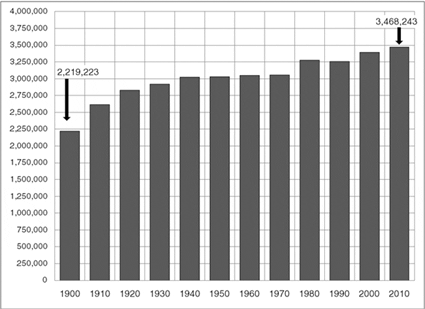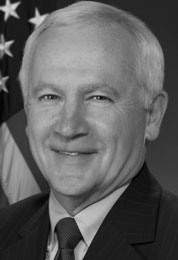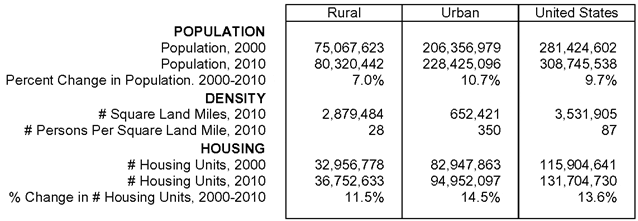Newsletters
- Home
- Publications
- Newsletter Archive
- Newsletter
May/June 2011
Inside This Issue:
- 2010 Census Reveals Slight Population Gain in Pennsylvania Rural Counties
- Counting All Rural Counties
- Chairman's Message
- Center Board Welcomes New Governor Appointees
- Census Shows Increase in Nation's Rural Population
- Research Examines Types, Quality of Regulated Child Care
- Distance Learning Offers Another Study Option for Rural GED Candidates
- Just the Facts: Structurally Deficient Bridges
2010 Census Reveals Slight Population Gain in Pennsylvania Rural Counties
Pennsylvania’s 48 rural counties had a 2 percent population gain from 2000 to 2010, according to the 2010 Census. Over the past decade, the state’s rural counties gained about 74,300 residents, for a total of 3,468,243 residents. That’s 27 percent of the commonwealth’s 12.7 million residents.
Pennsylvania’s 19 urban counties experienced a 4 percent increase in population over the past decade. From 2000, the urban county population grew by about 347,000 to total 9.2 million in 2010. Urban residents make up 73 percent of the commonwealth’s population.
Ups and downs
The increase in Pennsylvania’s rural population was tipped toward the eastern region of the state. These counties, which include Carbon, Juniata, Monroe, Pike, Union, Wayne and Wyoming, had an average population gain of 7 percent. Rural counties in the western region of Pennsylvania had a 1 percent decline.
In addition to these regional differences, there are two other differences between the 23 rural counties that gained population and the 25 rural counties that lost population over the past decade.
Rural counties that gained population had a higher percentage of non-white residents (8 percent) and Hispanic/Latino residents (4 percent) compared to counties that lost population (5 percent non-white residents and 1 percent Hispanic/Latino residents). Also, rural counties that gained population had a greater increase in new housing units from 2000 to 2010 than counties that lost population (11 percent and 2 percent, respectively.)
Throughout rural Pennsylvania, approximately 21 percent of the population was younger than 18 in 2010. That is a 2 percentage point decline from 2000.
Rural counties that lost population had a steeper decline in the number of youth from 2000 to 2010 (12 percent) than rural counties that gained population (1 percent).
Digging deeper
To gain a better understanding of why some rural counties gained population and others did not, the Center for Rural Pennsylvania analyzed data from the 2005-2009 American Community Survey (ACS), the Pennsylvania Department of Health, and the Internal Revenue Service (IRS).
While these data cover slightly different time periods than the 2000 to 2010 Census data and cannot be compared with the Census data, they do provide an in-depth look at the characteristics of rural counties and offer further insight about the counties that gained and lost population.
According to the 2005-2009 American Community Survey data, rural counties that gained population from 2000 to 2010 had higher housing values ($180,100 vs. $115,600), on average, than rural counties that lost population. Rural counties that gained population also had higher average household incomes ($60,600 vs. $50,000) and higher percentages of adults (25 years old and older) with a bachelor’s degree or higher (21 percent vs. 16 percent) than rural counties that lost population.
Other indicators that affect county population are births and deaths and in-migration and out-migration. According to Pennsylvania Department of Health birth and death data from 2000 to 2009, rural counties with an increase in population had more births than deaths, while rural counties with population decline had more deaths than births.
Also, according to Internal Revenue Service (IRS) migration data, from 1999-2000 to 2007-2008, rural counties that gained population from 2000 to 2010 had a net gain of out-of-state residents while counties that lost population had a net loss. Specifically, counties that gained population had 66,900 more people move in from out-of-state than move out, and rural counties with population loss had about 23,500 more people move out than in.
Noting the trends
In general, these data confirm several trends affecting rural Pennsylvania counties for the past few decades. Since 1980, rural Pennsylvania counties have been experiencing slow, incremental increases in population, with eastern counties realizing more gains than western counties.
Over the past decade, in-migration has positively affected the rural population more so than births.
Also, Pennsylvania’s rural population is aging as there continues to be a decline in the number of residents who are under 18 years old.
Pennsylvania's Rural County Population, 1900 to 2010

Data source: U.S. Census Bureau
Counting All Rural Counties
Did any rural Pennsylvania county become an urban Pennsylvania county because of population gains over the past decade? Not according to the Center for Rural Pennsylvania’s definition of rural.
The Center bases its rural definition on the statewide population density. In 2010, the statewide population density was 284 persons per square land mile. Counties that have population densities below 284 are considered rural, and those with population densities at or above 284 are considered urban. According to this definition, there are 48 rural counties and 19 urban counties in Pennsylvania. The same number as in 2000.
What changed from 2000 to 2010 was the state’s population density. It went from 274 people per square land mile in 2000 to 284 people per square land mile in 2010. The increase was largely driven by population growth in urban counties, which saw a population increase of more than 347,000 people from 2000 to 2010. During this period, rural counties had a modest population increase of 74,300.
The Center’s definition of rural and urban school districts is also based on population density. In 2010, 235 school districts in Pennsylvania had population densities below 284 people per square mile, while 265 districts had densities at or above this level. From 2000 to 2010, 11 school districts shifted from rural to urban and three districts shifted from urban to rural.
For more information on the Center’s definition or rural and urban counties and school districts, visit the Center’s website at www.rural.palegislature.us. Updates to the Center’s municipal definition will be made after the U.S. Census Bureau releases urbanized data in 2012.
Chairman's Message
 As the new Board Chairman of the Center for Rural Pennsylvania, I am eager and optimistic to continue the exemplary work of my predecessors to address important rural needs and trends.
As the new Board Chairman of the Center for Rural Pennsylvania, I am eager and optimistic to continue the exemplary work of my predecessors to address important rural needs and trends.
I am no stranger to the myriad issues affecting many of our rural communities. Elected to the State Senate in 2008, I represent the second largest rural district, which consists of Bradford, Lycoming, Sullivan, Susquehanna and Union counties. As a result, I have a vested interest in the policy considerations of the Center’s research programs and its extensive database on rural trends and conditions. In addition, I find the Center’s information and services to be very helpful to myself and my constituents.
In April, my first official act as Board Chairman involved the approval of targeted topics for the Center’s annual Research Grant Program. The topics for potential research cover a wide range of issues, including an examination of century farms, the implementation of electronic health records in rural Pennsylvania, an examination of postsecondary educational debt, and guardianship services in the state.
Additionally, as a result of the Marcellus Shale industry in Pennsylvania, the Center will take an in-depth look at four rural counties over multiple years and focus on a number of indicators in the areas of economic development, community services and infrastructure. Increased investment driven by the natural gas industry has resulted in the growth of new businesses locating to Pennsylvania, the expansion of many existing businesses, increased job opportunities and a greater need for residential and commercial infrastructure to serve this growth.
I am hopeful that faculty from Penn State, the State System of Higher Education universities and the regional campuses of the University of Pittsburgh, who are eligible for the Center’s Research Grant Program, will present some very competitive proposals on this topic.
Ultimately, this research will contribute a wealth of information on the natural gas industry’s economic and social impact in Pennsylvania.
For more information on the 2012 Request for Proposals and the full list of targeted topics, I encourage you to visit the Center’s website at www.rural.palegislature.us.
Once again, I look forward to my role as Board Chairman and will ensure that the Center’s continued viability in the state, especially rural Pennsylvania, will continue.
Senator Gene Yaw
Center Board Welcomes New Governor Appointees
 Stephen M. Brame |
 Taylor A. Doebler III |
The Center for Rural Pennsylvania’s Board of Directors welcomed Stephen M. Brame and Taylor A. Doebler III to the board in April. Mr. Brame and Mr. Doebler were appointed to the board by Governor Tom Corbett.
Mr. Brame is vice president of Public Affairs and Members Services for the Pennsylvania Rural Electric Association/Allegheny Electric Cooperative (PREA).
Prior to joining PREA in 2001, Mr. Brame served as a senior staff member for former Pennsylvania Lieutenant Governor and Governor Mark S. Schweiker.
Among his responsibilities in the Lieutenant Governor’s office were legislative priorities, General Assembly relations and communications strategy.
Mr. Doebler owns and operates T.A. Seeds LLC, an agricultural seed supply business in Jersey Shore, Lycoming County.
He is a board member of the Pennsylvania Corn Growers Association, Pennsylvania Seedsmen’s Association, PennAg Industries, Penn State Agricultural Council, and the Mid-Atlantic Master Farmer Association. He also is a member of the Susquehanna River Basin Commission, Pennsylvania Farm Bureau, and Farm Service Agency.
Mr. Doebler is the recipient of the 2010 Mid-Atlantic Master Farmer award.
He graduated from Pennsylvania State University and has received continuing education credits from Purdue University’s American Seed Trade Association Management Academy.
Census Shows Increase in Nation's Rural Population
Like Pennsylvania’s rural population, the nation’s rural population increased over the past decade, according to results from the 2010 Census. From 2000 to 2010, the number of rural Americans increased 7 percent. In 2010, there were 80.3 million rural residents nationwide, accounting for 26 percent of the nation’s population.
The nation’s urban population increased 11 percent during the last decade. In 2010, there were 228.4 million urban residents or 74 percent of the nation’s population.
From 2000 to 2010, Delaware, Florida, Hawaii, and Utah had the highest rural population increases, with each realizing a 20 percent or more increase in its rural population. Over the past decade, eight states had declines in their rural population. They are Arkansas, Iowa, Kansas, Louisiana, Mississippi, Nebraska, North Dakota, and South Dakota.
Rural and Urban Population, Land Area, and Housing in United States, 2000 to 2010*

*According to the Center for Rural Pennsylvania’s definition, a county is rural if its population density (number of persons per square mile) is below the statewide population density of 284. Counties with a population density at or above the statewide density are considered urban. In 2010, there were 2,362 rural counties and 781 urban counties in the U.S. Data source: U.S. Census Bureau.
Research Examines Types, Quality of Regulated Child Care
These days, child care is a regular experience for many children during their early years. Research has shown that children who attend higher quality child care enter school better prepared and continue to do better in the early years of schooling.
To learn more about the types and quality of child care in rural Pennsylvania, Dr. Elizabeth E. Manlove of Lock Haven University, Dr. Margaret S. Benson of Penn State University-Altoona and Dr. Martha J. Strickland and Dr. Richard J. Fiene of Penn State University-Harrisburg conducted research in 2009-2010 to compare regulated child care in rural and urban Pennsylvania counties.
Specifically, the research explored the types of licensed child care available, child care quality, and the types of care most often used by families who receive subsidies in rural and urban counties. They also explored the availability of nontraditional hours of care.
The researchers used 2008 data from the Pennsylvania Office of Child Development and Early Learning (OCDEL) and Environment Rating Scales assessment data from the 2002 Pennsylvania Early Childhood Quality Setting Study. To explore child care quality, the researchers examined participation in the voluntary Keystone STARS quality rating program and the T.E.A.C.H. Early Childhood program, both implemented by the Pennsylvania Department of Public Welfare. They also examined Environmental Rating Scales (ERS) assessment data completed by OCDEL.
The research found that the majority of licensed child care available in both rural and urban counties was child care centers (84 percent and 92 percent, respectively), followed by family child care and group homes.
The research also revealed that the majority of providers participating in the Keystone STARS program were child care centers. This was true for providers in both rural and urban counties.
In terms of the T.E.A.C.H. Early Childhood program, the research found active participants in both rural and urban counties and that rates of participation were similar across all types of child care. However, there were seven rural counties in the state that had no participants. The research also found that a large proportion of participants failed to complete their contracts in the T.E.A.C.H. Early Childhood program, although no data were available on the reasons why these participants did not complete the contracts.
The results indicated that the overwhelming majority of children in rural counties who received child care subsidies were cared for in regulated child care settings. However, there was considerable county-by-county variability.
The research also found that the proportion of providers offering care during nontraditional hours, which are 6 p.m. to 6 a.m. and weekends, was low throughout the state; in 23 rural counties, there were no centers offering nontraditional hours of care.
For a copy of the report, A Comparison of Regulated Child Care in Rural and Urban Pennsylvania, call or email the Center for Rural Pennsylvania at (717) 787-9555 or info@rural.palegislature.us, or visit www.rural.palegislature.us.
Distance Learning Offers Another Study Option for Rural GED Candidates
Distance learning (DL) is a promising way to enable geographically isolated youth and adults to obtain a GED (General Educational Development) credential. In DL courses, students may complete all or part of an educational program in a separate location from the institution hosting the program. Typically the program incorporates print, television, video, radio, the Internet, or other technologies.
In 2009-2010, Dr. Esther Prins, Brendaly Drayton and Ramazan Gungor of Pennsylvania State University and Dr. Cathy Kassab investigated the types, use, and effectiveness of DL for GED candidates in rural Pennsylvania to provide information on enhancing DL study options.
Specifically, the study, which was sponsored by the Center for Rural Pennsylvania, sought to: identify the types and use of GED distance education in rural Pennsylvania; describe the demographic characteristics and participation patterns of rural GED students in DL and face-to-face classes; determine the effectiveness of DL in preparing rural students to pass the GED tests; assess the cost of DL provision; and examine the advantages and disadvantages of DL for GED study.
The data sources used by the researchers included the Bureau of Adult Basic and Literacy Education’s (ABLE) e-Data system and GED Demographics survey, a telephone survey of non-ABLE DL providers, and telephone interviews with a key informant and DL staff and students from ABLE-funded programs. Other data used for the study included: the ABLE-funded Distance Learning Project’s student record, survey, and cost data; and a 2007 survey of ABLE-funded DL agencies.
According to the research results, from July 1, 2004 to December 31, 2008, 4 percent (975) of rural students in ABLE-funded GED classes participated in DL, with 47 percent of their instructional hours in DL. About 75 percent of these students participated in DL and face-to-face instruction. The research identified only four non-ABLE-funded organizations that provided GED DL classes for rural students.
The research found that DL is as effective as face-to-face classes in preparing students to pass the GED tests. The pass rate for rural DL students was 75 percent, compared to the national rate of 73 percent in 2008.
The effectiveness of DL, coupled with the limited number of DL providers and students using these services, indicates great potential for the expansion of DL in rural regions.
The estimated average cost of DL provision for Pennsylvania adult learners ($361 to $688 per student) was comparable to other states.
Print-plus-computer was the most common DL instructional format. Despite the limitations of print materials, they are widely used because programs and students lack the technological and financial resources that interactive, online instructional tools require. These results highlighted the need to provide professional development and financial resources for technologically sophisticated instruction, and to ensure affordable broadband and computer access in rural areas.
In general, rural DL students tend to be young, white, low-income women with a 10th grade education.
In addition, 22 percent of rural DL students are single parents; 35 percent are employed; and 38 percent receive cash or in-kind public assistance. A substantial minority (18 percent) of rural DL students have learning or other disabilities. These characteristics indicate a need for basic-level instructional resources and support services to overcome barriers to DL participation.
To take and pass the GED tests, rural DL students need to access testing sites. In 2009, about three out of four rural Pennsylvania counties had at least one public GED testing site.
In general, the research found that DL offers students: more options to study for the GED tests, enhanced academic growth, convenience and flexibility, the ability to combine GED study and work, the ability to study independently and at their own pace, and confidentiality.
Advantages of DL for educational providers included increased enrollment, retention and performance on accountability measures, and expanded instructional offerings.
The perceived disadvantages and challenges of DL were students’ restricted computer and Internet access, limited awareness of DL’s existence and value, insufficient DL funding, and educational issues such as teacher-student communication, provision of timely help and feedback, and student struggles with isolation, time management, and difficult subject matter.
For a copy of the research results, GED Preparation Through Distance Learning in Rural Pennsylvania, call or email the Center for Rural Pennsylvania at (717) 787-9555 or info@rural.palegislature.us or visit www.rural.palegislature.us.
Just the Facts: Structurally Deficient Bridges
Nearly one quarter of Pennsylvania’s 31,662 bridges is structurally deficient, according to 2010 data from the Pennsylvania Department of Transportation (PennDOT)
As PennDOT defines it, structural deficiency is an indication of a bridge’s overall structural soundness and its ability to service the traveling public. A structurally deficient bridge has deterioration to one or more of its major components.
In rural Pennsylvania, 24 percent of the 18,550 bridges are considered structurally deficient.
In urban Pennsylvania, nearly 23 percent of the 13,112 bridges are structurally deficient.
More than 81 percent, or 15,051, of rural bridges are owned and maintained by PennDOT. About 21 percent of these state-owned rural bridges are structurally deficient.
Among locally owned rural bridges, about 36 percent are structurally deficient.
From 2007 to 2010, the average sufficiency rating of a state-owned rural bridge rose from 76 to 78, while the average rating of a locally owned rural bridge dropped from 67 to 66. Sufficiency ratings indicate a bridge’s performance capability on a scale of 0, which is entirely insufficient, to 100, which is entirely sufficient.
Of the 31,662 bridges in Pennsylvania, more than 50 percent were constructed before 1960. In rural Pennsylvania, the average state-owned, structurally deficient bridge is 64 feet long and was built in 1938.
The average locally owned, structurally deficient bridge in rural Pennsylvania is 52 feet long and was built in 1935.
To ensure safety, PennDOT has closed some bridges or has imposed weight limitations on them.
In rural Pennsylvania, 11 percent of state-owned, structurally deficient bridges have posted weight restrictions and 56 percent of locally owned bridges have similar postings.
Of the structurally deficient bridges in rural areas, 2 percent of state-owned and about 9 percent of locally owned bridges are closed or temporarily closed.
